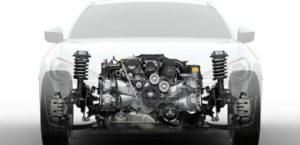The 2.5-liter Nissan VQ25DE engine (or VQ25 for short) was first shown in 1994 as the main power unit for the popular Cefiro, Cedric or Leopard models on the Japanese market. In 2004, the motor was slightly updated and began to be installed on the Fuga, Teana sedans and the Elgrand minivan. It was installed on Renault and Samsung cars under the V4U index.
The VQ20 series: VQ20DE, VQ23DE, VQ25DE, VQ25DET, VQ25DD, VQ25HR.
Specifications
| Start of production | 1994 |
| Displacement, cc | 2495 |
| Fuel system | distributed injection |
| Power output, hp | 190 (1994 version) 185 – 210 (2004 version) |
| Torque output, Nm | 235 (1994 version) 230 – 265 (2004 version) |
| Cylinder block | aluminum V6 |
| Block head | aluminum 24v |
| Cylinder bore, mm | 85 |
| Piston stroke, mm | 73.3 |
| Compression ratio | 9.8 (1994 version) 9.8 – 10.3 (2004 version) |
| Features | ECCS, NDIS |
| Hydraulic lifters | no |
| Timing drive | three chains |
| Phase regulator | no (1994 version) CVTC at the intake (2004 version) |
| Turbocharging | no |
| Recommended engine oil | 5W-30 |
| Engine oil capacity, liter | 4.0 |
| Fuel type | petrol |
| Euro standards | EURO 3/4 (1994 version) EURO 4/5 (2004 version) |
| Fuel consumption, L/100 km (for Nissan Cefiro 2002) — city — highway — combined |
14.4 7.7 10.1 |
| Engine lifespan, km | ~330 000 |
| Weight, kg | 185 |
The engine was installed on:
- Nissan Cefiro 2 (A32) in 1994 – 2000; Cefiro 3 (A33) in 1998 – 2004;
- Nissan Cedric 9 (Y33) in 1995 – 1999;
- Nissan Elgrand 2 (E51) in 2002 – 2010;
- Nissan Fuga 1 (Y50) in 2004 – 2007;
- Nissan Gloria 10 (Y33) in 1995 – 1999;
- Nissan Leopard 4 (Y33) in 1996 – 1999;
- Nissan Teana 2 (J32) in 2008 – 2013;
- Renault Latitude 1 (L70) in 2010 – 2015;
- Samsung SM5 1 (A32) in 1998 – 2005; SM5 3 (L43) in 2009 – 2019;
- Samsung SM7 2 (L47) in 2011 – 2019.
Disadvantages of the VQ25DE engine
- The main problems are caused by catalyst crumbs entering the combustion chamber;
- An oil burner exceeding 1 liter / 1000 km hints at the appearance of a scuff in the cylinders;
- The engine is afraid of overheating, from which mating surfaces quickly warp;
- After 200,000 km of run, it often stretches here and the timing chain begins to rattle;
- The culprit for floating speeds is often a dirty idle valve;
- Oil oozes from under the valve cover and from the camshaft position sensors here.






